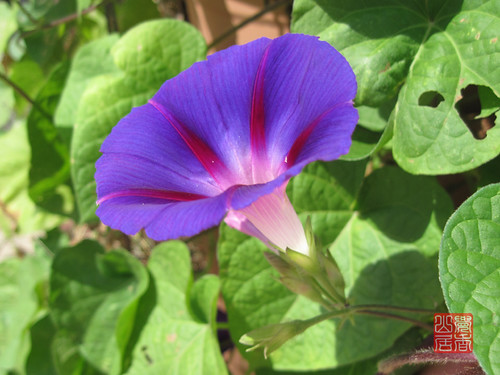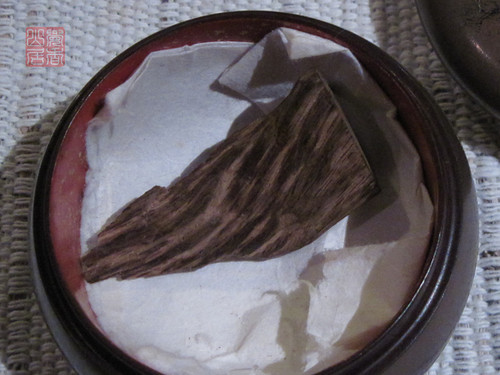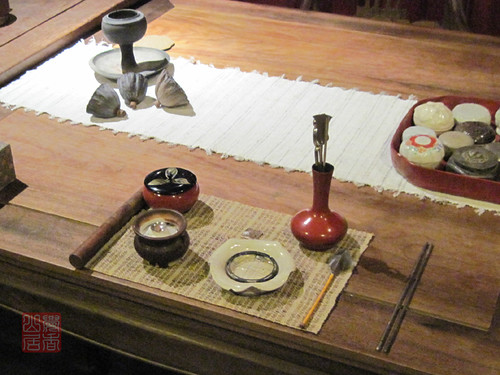... Tea helps build the connection to ourselves and to those around us. Tea helps achieving relaxation, bringing harmony and connecting with each-other as a family. In addition to the positive mental connections to drinking Tea, the beneficial properties of Tea builds on those that you receive from practicing yoga.(read whole article here)
Monday, October 24, 2011
Tea and Yoga Practice
I like this simple expression of tea and yoga:
Labels:
tea-culture,
yoga
Monday, October 10, 2011
My new Ashtanga Mysore class experience
This month, I just began my small-class training in the Ashtanga Mysore style with a local certificated instructor.
- The teacher stopped me at the point of Marici C, because I could not bind with joint hands on my right knee (I can do it on the left side though)!
- So, I'm now stucking with this asana and trying to accomplish it on my right side.
- In the Ashtanga tradition, asana sequence is strictly followed. A beginner is introduced one asana at a time, and until you accomplish that asana, you are not allowed to proceed to the next. However, all finishing asanas are encouraged, which usually include the Sarvanga (Shoulder stand) series, Shirsha (Head stand) series and the Padma series plus Shavasana. Modifications are given (only) when you have injuries preventing you to do the full pose.
- This is exactly the case in the class I'm attending. The teacher encourages not only finishing poses but also backbend practice.
- The small sized class is entense for me for now.
- The teacher makes sure all the time that the students are following the sequence -- which means no skips, no changing order, and NO modifications!
- If you can't do an asana, you learn how to do it.
- Into the 2nd week (I'm attending a 3 times/week schedule), my right knee pain got severe to a point that I can't do any lotus. I can't even do Janu-shirsha on my right side.
- I think it was the standing Ardah-baddha-padma asana and a deep full lotus (was the deepest I've never attempted) at the end of one session literally killed my right knee -- I had previous similar experience, but usually recover by itself in a few days so I think this time it's really serious.
- So, for the rest of the week day classes, I was given "modification" as said, but it is not the thing you will do in a so called "modified primary" class in popular yoga center. Here, I was still asked to do THE pose in the same manner, but using props and stopping at the point of pain. As for Ardha-baddha-padma, I was still crossing my right leg but put the right foot to the outside of the left thigh. Using a large rubber band, get my right hand bind with the righ foot, and bend upper body after ensuring right hip opening (right knee point straight downwards).
- The difference between "stretching" and "tearing" -- the latter should be avoide at all expense.
- The pain IS a result of practicing yoga asana, and not because of doing other sport activities or from whatever incidence - this is no doubt. But that still doesn't mean that the yoga asana caused the pain. It has to be because I tried to get the knee into deep lotus before having the hip join fully opens.
- I would emphasize that the pain is NOT an injury, because full range of motion is still there; plus, I don't feel pain by doing daily body movement, such as walking, sitting, and jumping up... It only felt when doing the specific asana posture - for me now, any lotus. I can't even do Janu-shirsha on my right side; and when seated with knee fully folded underneath, will have sensation of pain in the right knee, especially when putting more weight on it. On the third day, getting into deep squat also became difficult, though I could still manage to do that. Once getting into the deep squat, the pain relieves. The situation will also improve after warm-up with a few rounds of Sun Salute.
- It's now clear to me that the knee, though being a hinge join, does allow some range of motion to let the fore leg flip inward (sole up, shin on top of the opposite groin). But this very allowance should be well conserved, because it can give an illusion that you can put your legs in lotus, but actually not in a safe and wory-free manner. The pain, or in other words, injury of ligarment, will not immediately show up at the time and even shortly after doing deep lotus. It usually comes on the next day, and the situation will only go worsen and a period of healing time will be required and how long will depends on how much you get injured or varies person to person. I'm right now keeping a record on seeing how many days it will take me to have all the pain gone and be able to do lotus again.
Labels:
yoga
Thursday, August 25, 2011
Black lentil sprouting
My first lentil pea sprouting experiment is successful! Today's recipe is sesame paste, Black Beluga Lentil sprout and molasses, sprinkled with some Shiso fumi furikake.
It takes only four days to sprout:
It takes only four days to sprout:
Labels:
vegan
Friday, August 5, 2011
Translating Tea
Building up a glossary -- Our special focus is not only on translating names of tea or tea products, but also on a deeper appreciation of tea such as equivalent term for taste, feeling and cultral-spiritual dimension of tea activities.
Reference sites
- A glossary for translation projects and communication by Sherab
Reference sites
Labels:
bibliography
Saturday, January 22, 2011
Vegan and fatty acids
-- Notes from reading Becoming Vegan: The Complete Guide to Adopting a Healthy Plant-Based Diet / Brenda Davis and Vesanto Melina
Fatty Acids
a basic component of fats and oils, are divided into the following categories
***Essential Fatty Acids (EFA)
The two polyunsaturated fatty acids required in the diet.
Long-Chain Polyunsaturated Fatty Acids
larger polyunsaturated fatty acid molecules.
Fatty Acids
a basic component of fats and oils, are divided into the following categories
- Saturated Fat (SFA)
- Monounsaturated Fatty Acids (MFA)
- Polyunsaturated Fatty Acids (PUFA)***
- Trans Fatty Acids
Saturated Fat (SFA) molecules completely packed or "saturated" with hydrogen. Generally hard at room temperature. Often considered "bad fats" because they have consistently been linked to an increased risk of heart disease and some forms of cancer.
Monounsaturated Fatty Acids (MFA) fatty acids having one spot in the carbon chain where hydrogen is missing. Fats high in these MFA are generally liquid at room temperature and semi-solid when refrigerated. These are generally considered "good fats"; they are beneficial to health and can protect against chronic diseases, especially heart disease. These are neutral or slightly beneficial in their effects on total cholesterol levels and do not decrease HDL ("good") cholesterol; may even slightly increase it. Some evidence show MFA reduce blood presure and enhance blood flow... Main dietary sources are olives, olive oil, canola oil, avacados, most nuts (except for walnuts and butternuts), high-oleic sunflower oil, and high-oleic safflower oil.
Polyunsaturated Fat (PUFA) fat molecules having more than one spot in the carbon chain where hydrogen is missing. Fats high in PUFA are liquid at room temperature and when refrigerated. Reviews concerning their health effects are inconsistent.... Main dietary sources are vegetable oils, seeds, nuts, grains, legumes, and other plant foods.
***Essential Fatty Acids (EFA)
The two polyunsaturated fatty acids required in the diet.
- Linoleic Acid a parent in the omega-6 fatty acids family
- Alpha-linolenic Acid a parent in the omega-3 fatty acids family
Long-Chain Polyunsaturated Fatty Acids
larger polyunsaturated fatty acid molecules.
- in omega-6 family: Linoleic Acid --converted-- Arachidonic Acid (AA)
- in omega-3 familty: Alpha-linolenic Acid --converted-- Eicosapentaenoic Acid (EPA) and Docosahexaenoic Acid (DHA)
Labels:
vegan
Wednesday, January 5, 2011
Steps to improve yoga back-bend post
Works on opening the shoulders and top of legs
YogaBody offers these two following practices:
Practice on lengthening the lower spine and opening the groins
-- from Vancouveryoga.com
YogaBody offers these two following practices:
- Hands-on-wall Downward Dog
- Lie on your belly on the floor; crown of head touching a wall
- Chest liftup and put hands on the wall like doing Downward Dog
- Relax and hang there for a minute, then 2 to 5 minutes
- Supta Vajrasana
- Master Vajrasana till comfortable bum on floor between feet
- Proceed to lean back, elbows first, lower your back and head to the floor
- Grab opposite elbows over your head; Relax totally for 2-5 minutes
Practice on lengthening the lower spine and opening the groins
-- from Vancouveryoga.com
- To maximize the benefit and minimize potential discomfort in backbends, the pelvis and lumbar spine must be positioned in a way that lengthens the lower spine and opens the groins. To prevent compression in the lumbar spine, the pivot point in the backbend must be the bottom or apex of the sacrum, not the base. Many yogis mistakenly pivot from the base which compresses the vulnerable joint between the the sacrum and L5 and can cause discomfort by pinching muscles and ligaments in the lumbar area.
- To experiment with these concepts, first warm up the spine with Catcow:
- on all fours, arch the back and tip the tail up to the ceiling on each inhalation; on each exhalation, round the back and tuck the tail and head under. Repeat slowly and with awareness for 2 or 3 minutes.
- Bow Pose is a good one in which to practice lengthening the lumbar spine and groins in backbends:
- Lie on your stomach with arms overhead. Reach back with your right hand to grasp the right foot.
- Inhale and press your pubic bone gently into the floor. This encourages you to center the pivot point of the arch in the backbend at the apex of the sacrum. As you inhale, lift your upper body and right thigh off the floor. Keep the back of the neck long. Exhale and return to the floor. Continue for several breaths then repeat on the left side.
- To contrast the results, do several movements without first pressing the pubic bone into the floor. Notice the increased compression in the lower back.
- If you are able, do the full pose by lifting both thighs and the upper body off the floor as you inhale and anchor the pubic bone into the floor. If you feel any compression in the lowback, practice one side at a time until you learn to lengthen the spine and pivot from the sacral apex.
- Do several more Catcows as a counterpose.
- Take this concept into more complex poses such as Camel and Wheel. The more you can lengthen the lumbar spine and maintain space between the vertebrae by lowering the pivot point of the backbend to the sacral apex, the less the compression and discomfort. Subtle energies can then flow more freely and you will receive maximum benefit from the energizing and cleansing backbends
Thursday, December 23, 2010
Saturday, November 20, 2010
Delivering a tea seminar to OWO
I was invited to deliver a tea seminar to the Ohio Women Organization. The topic I gave was:
On the Aesthetics of Tea Arrangement 茶席的美學
(details forthcoming...)
On the Aesthetics of Tea Arrangement 茶席的美學
(details forthcoming...)
Labels:
tea-culture,
tea-gathering
Friday, September 17, 2010
Pawpaw Sandwich
September is the month of a feast on autumn wildness tastes! Persimmons, Eastern Black Walnuts, and yes, the Pawpaws are some of the mother nature's gifts I'm gratefully accepting. Well, certainly you have to "search" for them, as they will not show up in the market. The discipline is, however: Don't take too many. You won't have time to process (and digest) them all at once if you come to be too greedy.

This morning, I made pawpaw sandwich, another way to enjoy this locally grown but exotic in taste fruit. I call it Vegan Butter!

This fall, I found a six-fruits-in-one - They are multiple fruits produced from a single flower! This really looks beautiful and interesting. It is said that "pawpaw fruits often occur as clusters of up to nine individual fruits." (source)

It's hard to describe the taste of pawpaws... To me, it's mango but no acid; banana but more fragrant; persimmon but not that sweet; pear but with custarda... A serious reader might want to consult the web sources and below are a few pages to begin with. However, if you are really serious about pawpaw, you should consider attend the Ohio Annual Pawpaw Festival!
......

This morning, I made pawpaw sandwich, another way to enjoy this locally grown but exotic in taste fruit. I call it Vegan Butter!

This fall, I found a six-fruits-in-one - They are multiple fruits produced from a single flower! This really looks beautiful and interesting. It is said that "pawpaw fruits often occur as clusters of up to nine individual fruits." (source)

It's hard to describe the taste of pawpaws... To me, it's mango but no acid; banana but more fragrant; persimmon but not that sweet; pear but with custarda... A serious reader might want to consult the web sources and below are a few pages to begin with. However, if you are really serious about pawpaw, you should consider attend the Ohio Annual Pawpaw Festival!
......
Friday, September 10, 2010
Morning glory
I love morning glories! and I'm particularly in favor of those purple or blue ones. They just add a wonderful refreshment in the morning, really. These are a light blue variety I found at roadside, Beijing, when I was traveling to there last month. The color is just so touching!


One thing about morning glories is that they are so modest in nature, and they thrive everywhere there's decent light and moisture. The trumpets of beauty sing the glory of the sun.
This dark purple one is in my patio. I took this picture a day after coming back from Beijing -- it's still in the season of morning glories!


One thing about morning glories is that they are so modest in nature, and they thrive everywhere there's decent light and moisture. The trumpets of beauty sing the glory of the sun.
This dark purple one is in my patio. I took this picture a day after coming back from Beijing -- it's still in the season of morning glories!
Labels:
flowers
Wednesday, June 2, 2010
Siddhasana problems
The importance of Siddhasana (Siddhāsana) does not need to be repeated here. One benefit in practising this asana is openning the hip joins, which is a prerequisite for Padmasana and other lotus postures (such as Ardha Baddha Padmottanasan). Some say that this seating posture is easier than Padmasana for in Siddhasana, you don't have to put the feet higher on top of the opposite thighs as required in Padmasana. In fact, it only looks easy but not so especially for beginner like me. Specifically, I find the following difficult points in siddhasana practice.
Reference
- What is the right position of the inner or lower foot? Should it be placed right below the perineum, the groin of the opposite leg, or touching the pubic bone of the same leg side?
- What exactly is achieved in terms of hip joint opening in this posture? In other words, what range of motion is improved?
- The relation of the (male) genitals to the two feet, and related concerns?
Reference
Labels:
yoga
Friday, April 23, 2010
Lecture on Chinese Tea Culture
I gave a lecture (with demonstration) on Chinese Tea Culture which is in the series of "China in a Global Context" hosted by the Institute for Chinese Studies, the Ohio State University.
Labels:
tea-culture,
tea-gathering
Wednesday, February 3, 2010
The Way of Tea to be presented on 2010 Ohio Chinese Festival
I have accepted, with honor, an invitation to perform "The Way of Tea" (茶道 or "Tea Ceremony") at the 2010 Ohio Chinese Festival. Not only I'm going to demonstrate the traditional way of tea, but also I intend to introduce some easy but proper ways of enjoying tea on a daily base (in other words, occassions such as when you are working at your office, or on the way to go).
Session I. Tea in the Way of Tradition (Modified Kongfu Cha style)
Here you will see how teas are prepared and shared with friends in a more traditional manner. Such an event is called a Tea Gathering (茶會/茶席). Aesthetics is revealed through the communication with tea, tea wares, and with people. Calm down and awaken your mind in the dialog with tea! We are demonstrating something called "modified kongfu cha" style. As the name applies, we will use tools adopted in the 功夫茶 kongfu cha traditions, but with add-ons and changes.
Session II. Tea the Easy Way
Tea is not only for leisure. Tea is first a healthy beverage. But the point is how to drink tea in a healthy way! We will bring some modern tea utensils designed for convenient tea making. These utensils are widely available at the market. Using these tools, we can enjoy a cup of tea any where any time, and receive the health benefits of tea with ease and with grace! Improper manners of tea making and some heath concerns in tea drinking will also be discussed.
Labels:
tea-culture,
tea-gathering,
tea-styles,
teawares
Friday, December 25, 2009
A Green in the Name of White

It's been a while I have not reviewed any teas seriously... but this doesn't mean that I'm out of teas. In fact, I keep getting new teas, many of which are gifts from friends, like this one I'm trying today.
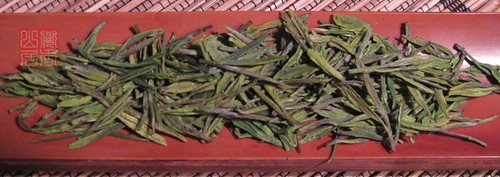
This a tea named Fuwei Bai Cha (富伟白茶) or Fuwei White Tea. The word "bai" means white. But, a look on the dry leaves revealed to me the truth that it is actually a type of green tea. And to be specific, it is a type of green tea in the category of chao qing (炒青) or "roasted green" so to speak. You may get confused for why a green tea is named white tea? To decode the "white" part in the name, we have to take a look on what it really means by "white" in the terminology of current industry as well as its historical meaning.
The terminology white used in "white tea" is ambiguous. It refers to two different entities: (1) The color of the tea leaf which is "white" or pale green, or is ivory colored (when the leaf is young) -- this is probably the original meaning; and (2) The "simplicity" in the process of the tea leaves, which means merely letting the leaves wither and then dry and pack them up.
In today's tea industry in China, among the five types of tea named by colors [1], it is in the second sense mentioned above that the White Tea is definied. An example of White Tea in this system is Bai Mu Dan (白牡丹) or White Peony.
In the ancient time (especially in Tang and Song Dynasties), White Tea is definied differently from that of the modern tea industry. It is more straight forward referring to the color of the leaves, and has nothing to do with the processing method. A tree that grow "white" colored leaves is considered a specialty. The taste of the tea made out of the white tea tree is said to be supreme [2]. In the ancient time, the procedures in tea manufactury is way more complicated than today's.
Back to today's tea. I did a small online research and found out that this tea is in one of the series of new products developed in the last couple of years, noticeably all from the west region of Lake Tai (太湖). Tea growers there claimed that they have re-discovered the ancient "White Tea", because they found a type of tea tree growing in mountains there which sprouts unique ivory colored leaves, similar to that described in ancient tea classics. And therefore, they call it "White Tea." Obviously, this naming has a great marketing purpose!
However, the tea is processed in the method of green tea. Therefore, by definition of modern tea industry, this type of tea is still a green tea. One of the most polular products in this series which has made a big marketing success is Anji White Tea (安吉白茶).
A search for the manufacturing location of this particular product I'm reviewing today results in a neiborhood of the Anji White!

In conculsion, we have been dealing with three types of "white tea" so far
- White Tea in the ancient sense: a special type of tea tree that grows white leaves. In Song Dynasty, teas are manufactured into tea cakes, and grinding the cake into tea powder is required before it can be consumed.
- White Tea in modern Chinese tea industry: tea leaves are picked and let withered simply by itself (without shaking or twisting as that in the process of Yellow or Oolong teas) and dried (under the sun or by heating); light fermantation occurs during the process of withering.
- A type of green tea called "white" in name only! Picked from a special type of tea tree that grows white leaves, processed in the manner of green tea, which means zero fermantation!
Now comes the actual review part....
The tea is well processed, the package looks nice, too. The dry leaves are flat in shape -- could be a major difference from Anji White which are not flat. The color is also more greenish in comparison of Anji's dull green. I made four infusions, the first one is done in the manner of throwing leave onto hot water (上投), which means you first pour boiling hot water into the gaiwan, and then throw the leave onto the water and let them slowly infused into the water. This is the way often employed for green teas of tender leaves. I used 4g of dry leaves to suit my 120cc gaiwan.

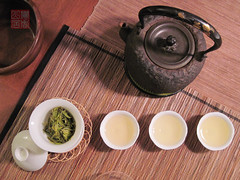

The taste is pretty decent as for a good green tea. It presented a little astringency which you will not experience with Anji White. Usually, astringency indicates the tea possesses less amino acid but more poly phenols. To me this is a good news, because more poly phenols means more EGCGs or the antioxidant element.
The spent leaves demonstrate the tea's specialty for which it is named: the pale greenish with a tone of ivory!

Notes
[1] The five types of tea are: Green Tea, White Tea, Yellow Tea, Oolong Tea (or Greenish Black), Black Tea.
[2] The supreme quality of White Tea is described in a Song Dynasty Tea Classic 《大觀茶論》.
Labels:
tea-reviews,
teas
Wednesday, December 23, 2009
Bibliography of Extended Readings
On 易經 Yi-jing (I-ching), The Classic of Change
- 易學今昔/余敦康 广西师范大学,2005
-- 分析中國儒道思想天人合一, 自然主義與人文主義的中道
Labels:
bibliography
Saturday, December 12, 2009
訪自在雅集-Animitta sabda gandha
Labels:
tea-culture,
tea-gathering
Wednesday, December 2, 2009
Literature review on tea culture and tradition
明代几种茶书成书年代再补 / 安徽农业大学中华茶文化研究所 丁以寿
Monday, October 19, 2009
Materials for research on the tea mthods reflected on 2 scroll paintings
傳為初唐閻立本的《蕭翼賺蘭亭圖》今存世的有兩卷, 一藏於遼寧博物館, 另一藏於台灣故宮博物院. 據學者考證[資料?]此二均宋代的摹本, 其中遼寧博物館所藏的是北宋摹本, 台灣故宮博物院所藏是南宋摹本.
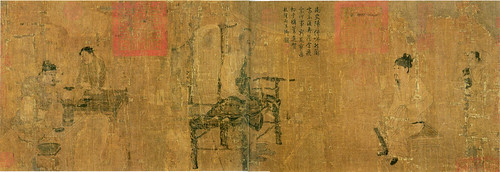
遼寧博物館所藏

台灣故宮博物院所藏
Literature review
李豔婷 遼博本《蕭翼賺蘭亭圖》作者考辨(天津美术学院学报 2007年第3期)
浩更 《蕭翼賺蘭亭圖》重現唐代煮茶風情(文化交流 2008年第5期;又转载于拙风文化网) -- 論點可質疑處頗多

遼寧博物館所藏

台灣故宮博物院所藏
Literature review
李豔婷 遼博本《蕭翼賺蘭亭圖》作者考辨(天津美术学院学报 2007年第3期)
浩更 《蕭翼賺蘭亭圖》重現唐代煮茶風情(文化交流 2008年第5期;又转载于拙风文化网) -- 論點可質疑處頗多
Labels:
bibliography,
tea-culture
Sunday, May 24, 2009
Pine needle motif on Japanese tea wares

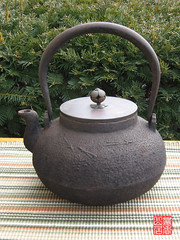
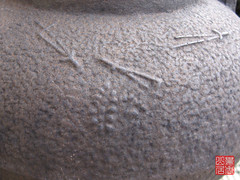 The first time this motif caught my eyes was when I bought a tetsubin with kanji 松風(wind through pine trees) on one side and some "strange" design on the other. At that time, I wasn't sure that the needle like leaves are pine needles and the fruit like thing is a pine cone. Later on I learned that this motif is called 松葉絵 matsu-e(drawing of pine needles). Sometimes, pine cones, called 松ぼっくり(松毬), are also accompanied.
The first time this motif caught my eyes was when I bought a tetsubin with kanji 松風(wind through pine trees) on one side and some "strange" design on the other. At that time, I wasn't sure that the needle like leaves are pine needles and the fruit like thing is a pine cone. Later on I learned that this motif is called 松葉絵 matsu-e(drawing of pine needles). Sometimes, pine cones, called 松ぼっくり(松毬), are also accompanied.Two things we can learn from this motif. First, as the pine leaves are depicted not on branch but as separate pairs of needles, this motif indicates the season to be late autumn, when the pines shed some leaves on the ground. The falling leaves, just as the falling of sakura flower in Spring, give a sense of the transient beauty. Second, as the needles are paired, or in fascicles of two, we can tell that the dominant pines trees in Japan are probably those similar to Red Pines or Scots Pines in Europe. Or, at least these are the pines that caught the artists' eyes...
The following are a few more examples of the pine needles motif on Japanese tea wares. Note the first one, a tea caddy, has both needles and pine cone, similar to the tetsubin. The second one, a red tea caddy, has bamboo leaves and plum flowers -- thus it makes another popular motif Sho-chiku-bai (松竹梅 pine-bamboo-plum), or Saikan Sanyuu (歳寒三友), literally, "the Three Friends of Winter."




This is a 松葉絵銘々皿 (matsuba-e-meimeizara; "meimeizara" are small plates for individual helpings of food) and it has a more realistic depiction of the pine needles --

Labels:
motif,
tea-culture,
teawares
Sunday, March 15, 2009
CCTV program features "drinkable antique" - old fine Puerh tea
CCTV now has a "Myths of sky-price" series, and one of them is the "Drinkable Antique (能喝的古董) - myths in old fine Puerh teas":
-- I'm trying to embed the video here, but it only ended up with a link! -- anyone can help me?? (Before I figure it out, you have to copy & paste this link to the address bar to watch the show. Sorry!)
标题:[走近科学]天价之谜(二)能喝的古董(2009.02.24)
URL:http://space.tv.cctv.com/video/VIDE1235490488700888
-- I'm trying to embed the video here, but it only ended up with a link! -- anyone can help me?? (Before I figure it out, you have to copy & paste this link to the address bar to watch the show. Sorry!)
标题:[走近科学]天价之谜(二)能喝的古董(2009.02.24)
URL:http://space.tv.cctv.com/video/VIDE1235490488700888
Labels:
tea-culture,
teas
Subscribe to:
Posts (Atom)










